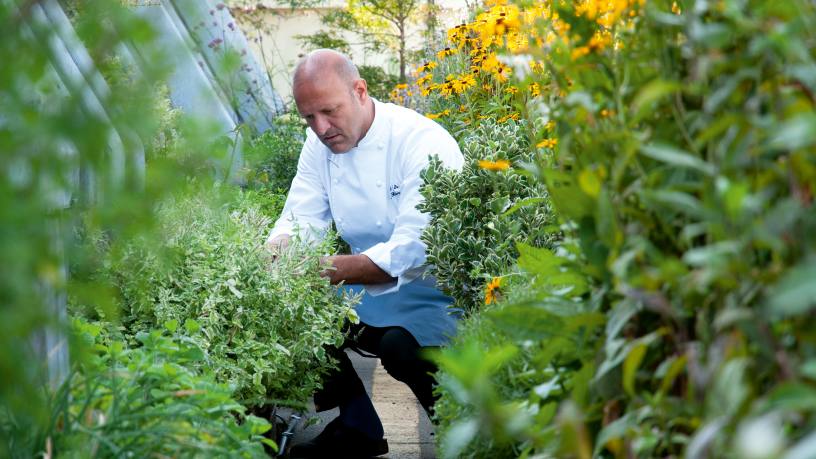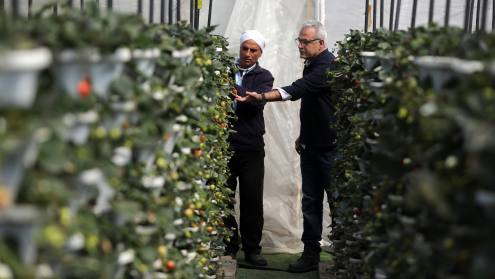The world is recognising the urgent action needed to transform the urban environment to tackle the climate crisis. According to the UN World Green Building Council Global Status Report 2017, buildings are one of the largest sources of greenhouse gas (GHG) emissions, accounting for more than half of total city emissions on average, and are a significant source of air pollution.
Many cities are starting to put in place transition plans. C40, a global network of nearly 100 mayors, has led the charge by launching the Net-Zero Carbon Buildings Declaration in 2018; signatories (28 to date, including five non-members) pledge to enact regulations or planning policy to ensure new buildings operate at net-zero carbon by 2030 and all buildings follow suit by 2050.
A C40 and McKinsey 2021 report, ‘Focused adaptation: a strategic approach to climate adaptation in cities’, recommends priority actions and outlines ways to implement a tailored adaptation plan. Actions could include: creating ‘green’ roofs that can mitigate urban heat-island effects, improve air quality and preserve biodiversity; roof farms to reduce the environmental impact of food delivery; or installing solar panels for energy conservation.
While banks have a crucial role to play in facilitating the financing programmes needed to fund cities’ transition plans, they are also looking at their own urban footprint. Some institutions have begun at the top, reimagining their roof space to support their sustainability commitments.
Biodiversity benefits
Green roofs are a regular sight across London, and have become an important place for biodiversity and conservation. For example, when Nomura moved into its London headquarters in 2010, the architects designed a green roof covering 20,000 square feet that has evolved from a simple sedum carpet to a biodiverse space. It is now home to 165 species of wildflowers, which add nectar-rich habitat for pollinators, such as 22 species of bees. In June 2021, rare small-flowered tongue orchids were discovered growing on the roof.
In addition to supporting biodiversity, Nomura has partnered with St Mary’s Secret Garden to support people’s wellbeing, as well as working with the ‘Buzzin Project’ for young people from disadvantaged areas. “By visiting the roof, they learn life skills and have built solitary bee mounds and bird boxes,” says Nina Swallow, environment and sustainability practitioner at Nomura. During the Covid-19 pandemic, the bank’s ecologist and beekeeper Mark Patterson was recognised as an essential worker. “The wellbeing of our bees is so important,” she adds.
Nomura’s wholesale governance officer, Andrew Bowley, believes that the green roof resonates with many people. “It’s essential for franchise reasons, as well as environmental and climate reasons. For us, the roof is symbolic of all of the work we do,” he says. Mr Bowley looks after the bank’s sustainability strategy, particularly for the wholesale investment bank, which spans a wide portfolio of advisory businesses, green and social bond issuance, balance sheet and sustainability commitments, such as net-zero and the Principles for Responsible Banking.
He points out the benefits of the green roof, including reducing air pollution and the effect of GHG emissions, as well as cutting air conditioning and energy consumption. “Sedum helps with heat absorption from the sun and rain absorption, so stormwater management is improved,” he says.
People talk about locally sourcing; how more local can you get than the terraced kitchen garden?
In addition to the roof garden, the bank has a terraced vegetable garden on the sixth floor, which is also a staff area. According to Ms Swallow, understanding the ‘foodprint’ — or the environmental impact of getting the food item from the farm to the plate — is important. “It is about identifying the source of your food, and is a great way to educate people about how they can reduce consumption and environmental impact through the food they eat,” she says. “People talk about locally sourcing; how more local can you get than the terraced kitchen garden?”
From roof to plate
Coutts, part of NatWest Group’s wealth management division, designed its London roof garden in 2012 to produce vegetables, herbs and fruit for use in the sumptuous meals created by Peter Fiori, executive chef at Coutts. The Skyline Garden, which was planned with the help of Urban Organic, is packed in tightly across 400 metres of outdoor corridors and has been a home to more than 18,000 plants over the years.
The garden has helped the business with its drive toward sustainability, reducing food deliveries and heightening the importance of seasonal produce. It has become the home for around 40,000 bees who benefit from the plants grown just for them including lavenders, foxglove, mints, rosemary, salvia, borage, oregano and verbena. In a bumper year before the pandemic, the hives yielded more than 40kg of honey.
“After the trials and tribulations over the last two years of the pandemic, there are fresh shoots of recovery,” says Mr Fiori. “The Skyline Garden is opening itself up to providing new products and welcoming back its fabulous fan club of guests.”
Mr Fiori created the ‘from harvest to plate’ Skyline Garden Cookbook, which features recipes using the garden produce, and the bank donates sales to the Felix Project, a charity that provides surplus fresh food to vulnerable people across London.
During the pandemic, all harvests were delivered to the Felix Project. Mr Fiori reports that during this time the garden developed a new spice element, growing new products such as turmeric, ginger, Szechuan pepper, galangal, kaffir lime and curry leaves.
“We are also introducing some additional dwarf root fruit trees to yield nectarines, flat peaches green gage and plums,” he says. “We now know which plants enjoy our rooftop environment, so we have developed our menus around this sustainability and rich variety of products. We are now inviting our guests to try for themselves.”
Mr Fiori has consistently advocated for more businesses to reimagine their rooftops, which he believes would make a positive impact on London’s air quality.
Solar farms
In addition to creating edible farms, some banks are looking at turning their rooftops into energy farms, which could not only help with their renewable energy targets but also support the community. “If a bank has a vast amount of unused roof space, especially in a data centre, the ability to generate its own energy and store it on site makes the bank much more energy independent, much less reliant on the grid,” explains Andy Schmidt, vice-president and global industry lead for banking at IT consulting firm CGI. “And when it gets hot, the heating, ventilation and air conditioning systems in data centres are working overtime, so lightening the load builds resilience into the grid.”
He continues: “During outages, depending on how much energy they’re able to store, banks may even be able to put energy back onto the grid to provide local power on a limited basis. It is a tangible way for banks to reduce their energy usage and, over time, reduce costs, because they’re able to create much more reliable sources of energy.”
Citi, for example, is taking the opportunity of refurbishing its Europe, the Middle East and Africa (EMEA) headquarters in London to install solar panels on the roof of the 42-story tower.
Kathryn Harrison-Thomas, EMEA region head of corporate realty services, says: “It is a very intuitive way to demonstrate Citi’s commitment to its net-zero targets. The entire company feels incredibly passionate about ensuring we are walking the talk. Anyone looking down at our building [from a plane] will see that this is an energy-efficient building and that we’re trying to attain as low a carbon footprint as possible in our operations.”
She reports that the solar farm will generate enough electricity, for example, to power 80 large UK homes a year. “We will be able to run the building using our solar panelling and even put back onto the grid at points when we’re over-generating, potentially during the summer months. This will help the country be more efficient and provide a lower cost energy to the community around us,” she adds.
Both the Citi Tower and the solar panelling are designed to meet the 2030 efficiency standards, so the bank will be ahead of government expectations, according to Ms Harrison-Thomas. The renovation is expected to be completed in 2025.
Remarking on the importance of the refurbishment project overall — which includes a greywater system, recyclable waste streams, as well as sustainable sourcing, for its building materials, and well-being zones for its employees — James Bardrick, Citi country officer for the UK and CEO of Citigroup Global Markets, says: “When we think about the future of work, our business and our organisation, it’s difficult to understate how important this commitment is to our employees, clients, the UK and London as a global financial centre. Citi bought the Canary Wharf tower in 2019 and is now reshaping it for the next 20-25 years.”
Wichita combination
Fidelity Bank, a US Midwest family-owned bank, has combined both an edible and an energy farm on the top floor of its new car park in Wichita, Kansas. Rise Farms consists of a 15,000-square-foot urban farm and a 204-panel solar farm, which provides power to the parking structure and the retail space on the ground floor.
According to Melissa Knoeber, executive vice-president and director of culture and talent, the whole project was done through the lens of people, in order to differentiate Fidelity Bank in the war for talent. The bank surveyed its staff — 64% of whom are female — as to their preferences, for example the types of tenants that could benefit the community. The tenant chosen for the ground-floor restaurant is First Mile Cantine, with an ethos of sourcing food from close by, which sparked the idea for the produce farm on the fifth floor.
The produce farm consists of four large planting fields, growing beds for the pollinators and a “hoop house” or polytunnel for seed germination, as well as an event pavilion currently under construction. “We’re gearing up for our first spring, summer and fall crop,” says Ms Knoeber. “The farm will work closely with the restaurant on the first floor, as well as providing an opportunity in phase two, through our volunteerism efforts with our corporate social responsibility division, for our folks to enjoy the food as part of our health and wellness initiatives. They can also work on the farm to learn to grow their own healthy food.
“Our goal in this first year is to provide fresh produce to the restaurant, get that into the hands of our employees and, of course, have no wasted food as we move forward,” she adds.
In addition to providing local produce, the green-roof farm lessens the urban heat-island effect, curbs building energy costs and prevents excess storm water run-off.
Fidelity Bank’s solar farm was also imagined through the lens of talent. “We wanted our staff to feel safe, so we designed [the car park] to be as bright as daylight,” she adds. The solar panels will generate enough power to keep the car park lit 24 hours a day, as well as power designated parking spots for employees’ electric cars.
While the bank does not plan to extend the farms at present, Ms Knoeber emphasises: “The knowledge that the project has brought the bank in that realm of being green, the impact that it can have on our community and the impact it can have on our folks’ wellness and health — we will absolutely take everything into consideration that could make our lives better in the future.”
Energy tech
When considering the evolution of energy farms in particular, CGI’s Mr Schmidt believes that a possible next step is creating a joint venture with a college or university, using a bank’s solar roof as a testbed. “Banks could set up partnerships with colleges or universities with great science, technology, engineering and mathematics programmes, or partner with renewable energy start-ups, to make advancements in the technology. They could also create dedicated investment vehicles or investment opportunities,” he says.
He believes that this would certainly be a visible way for banks to lead the way towards sustainability. “It would be fantastic to have a situation where a technology that’s pioneered on the roof of your local bank branch is put into production on a massive scale to drive clean energy generation,” Mr Schmidt says.








